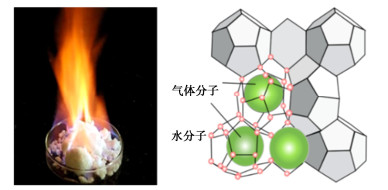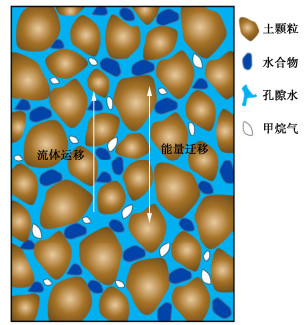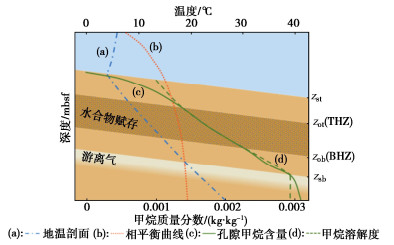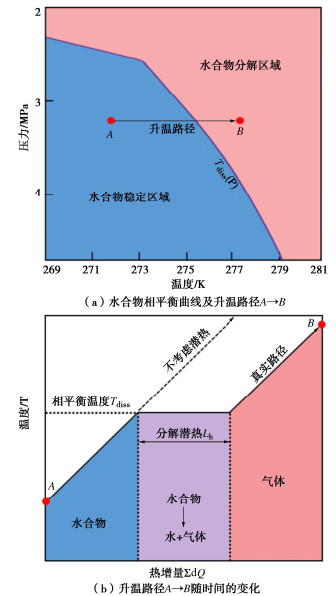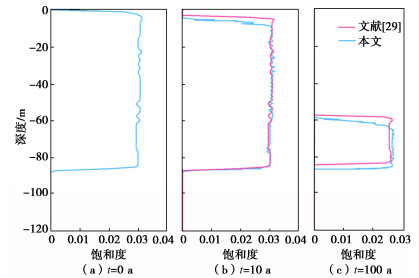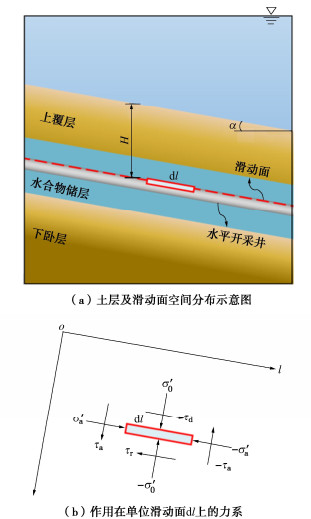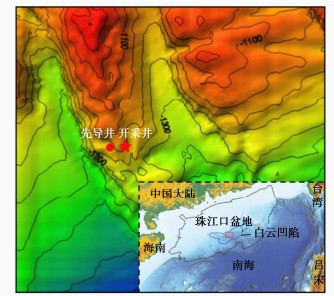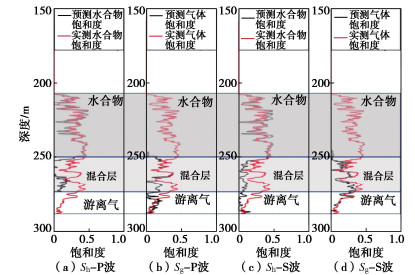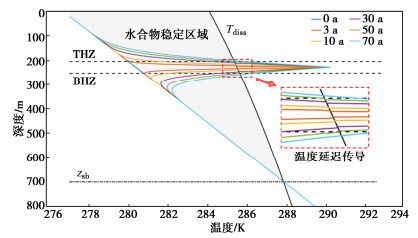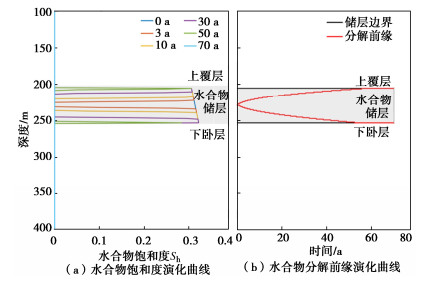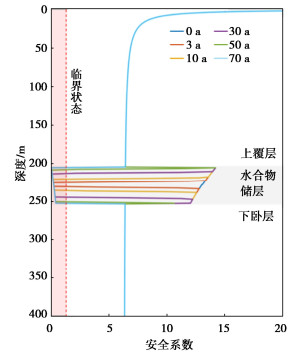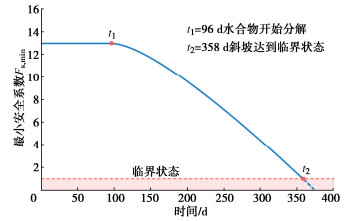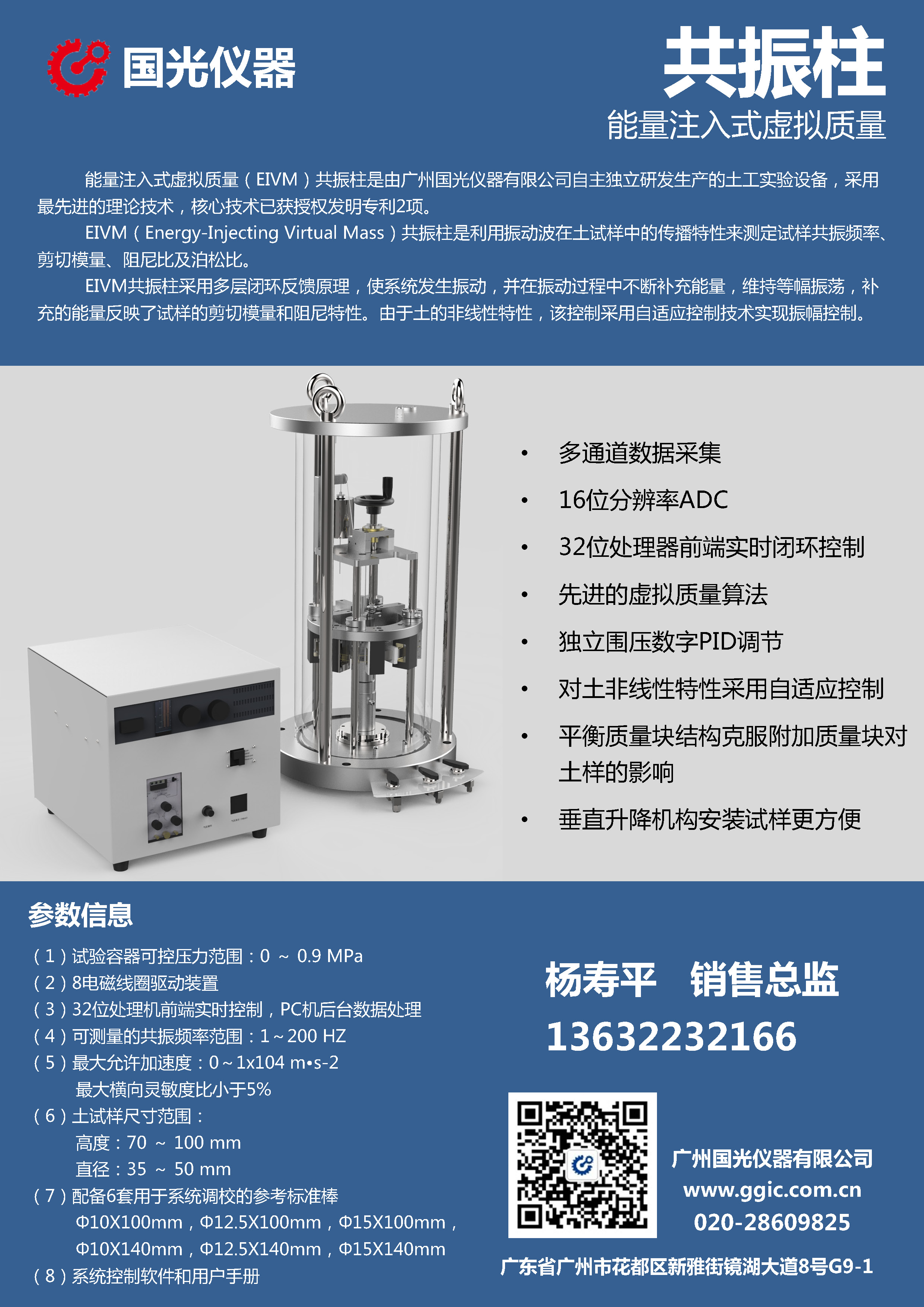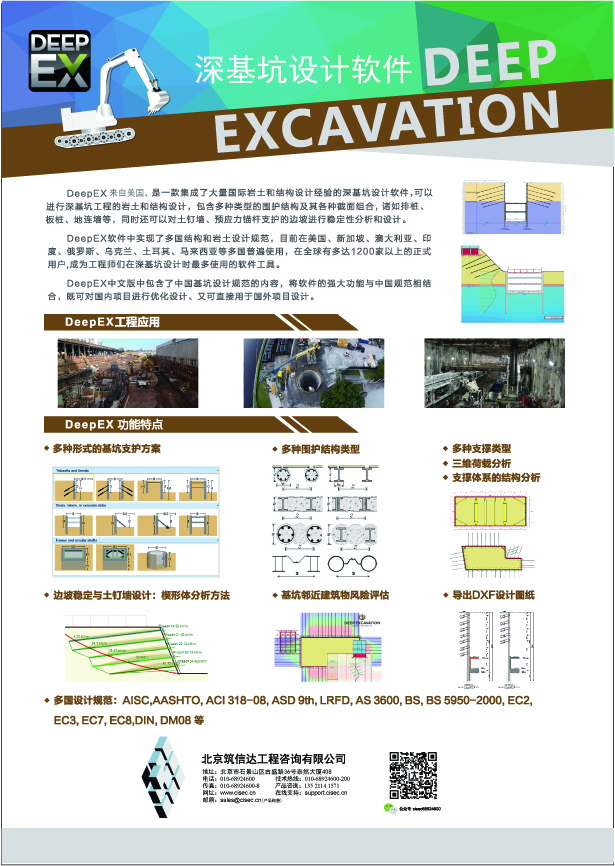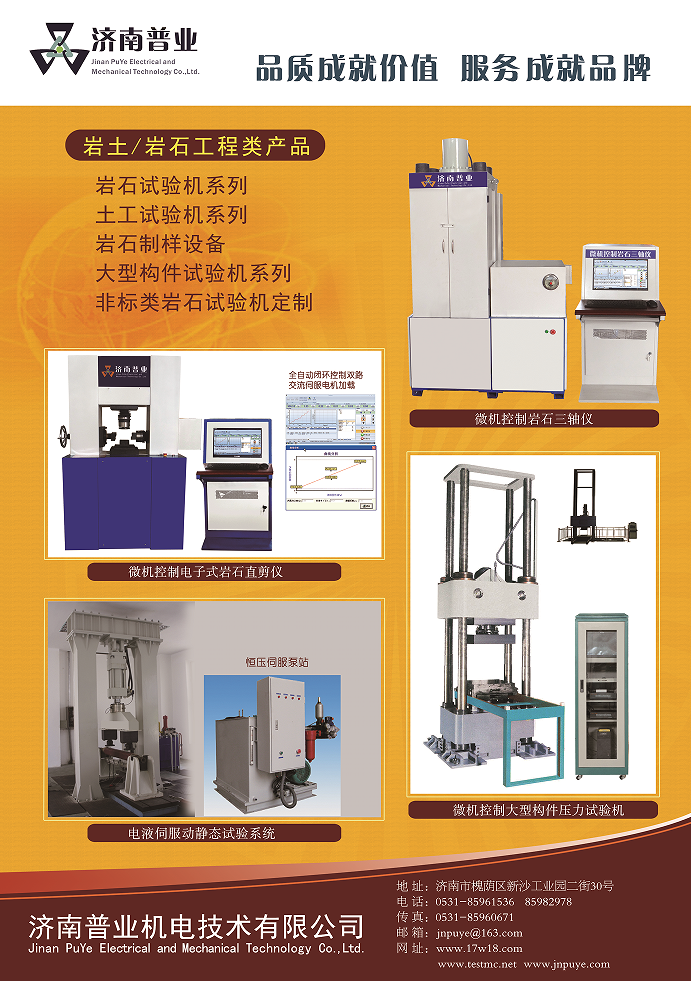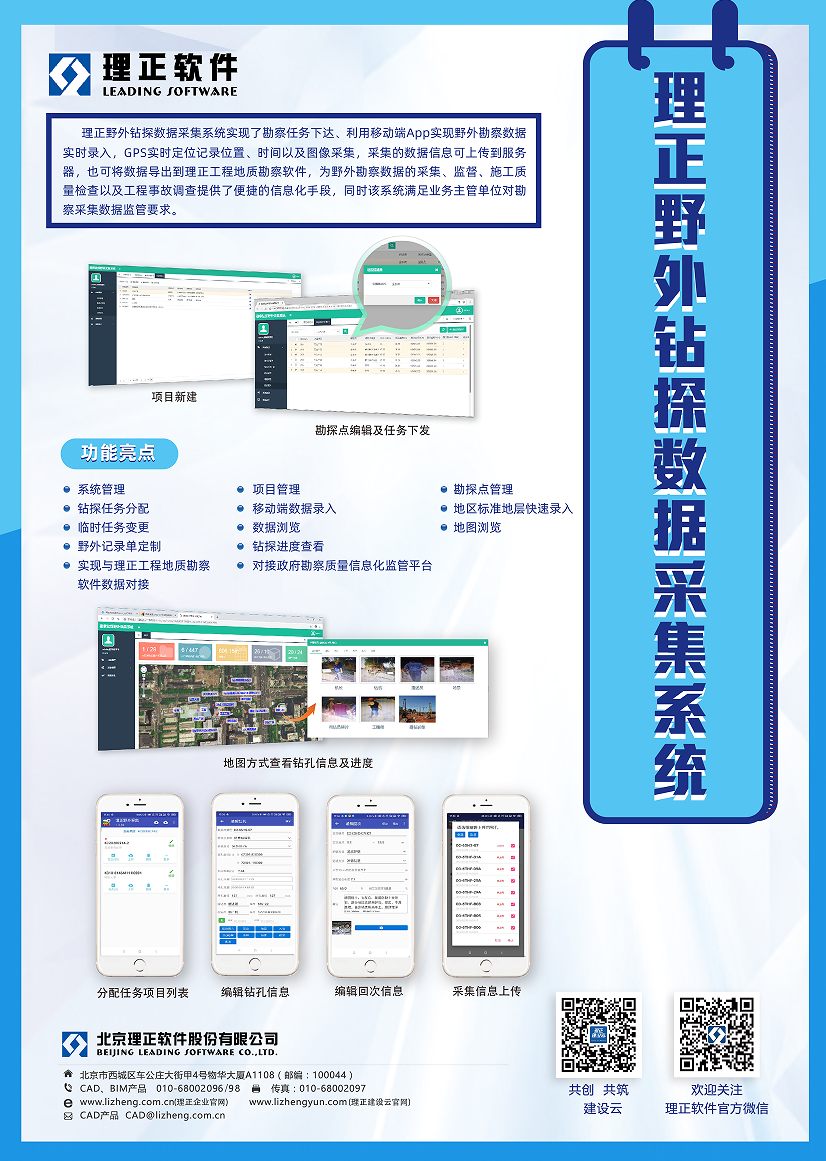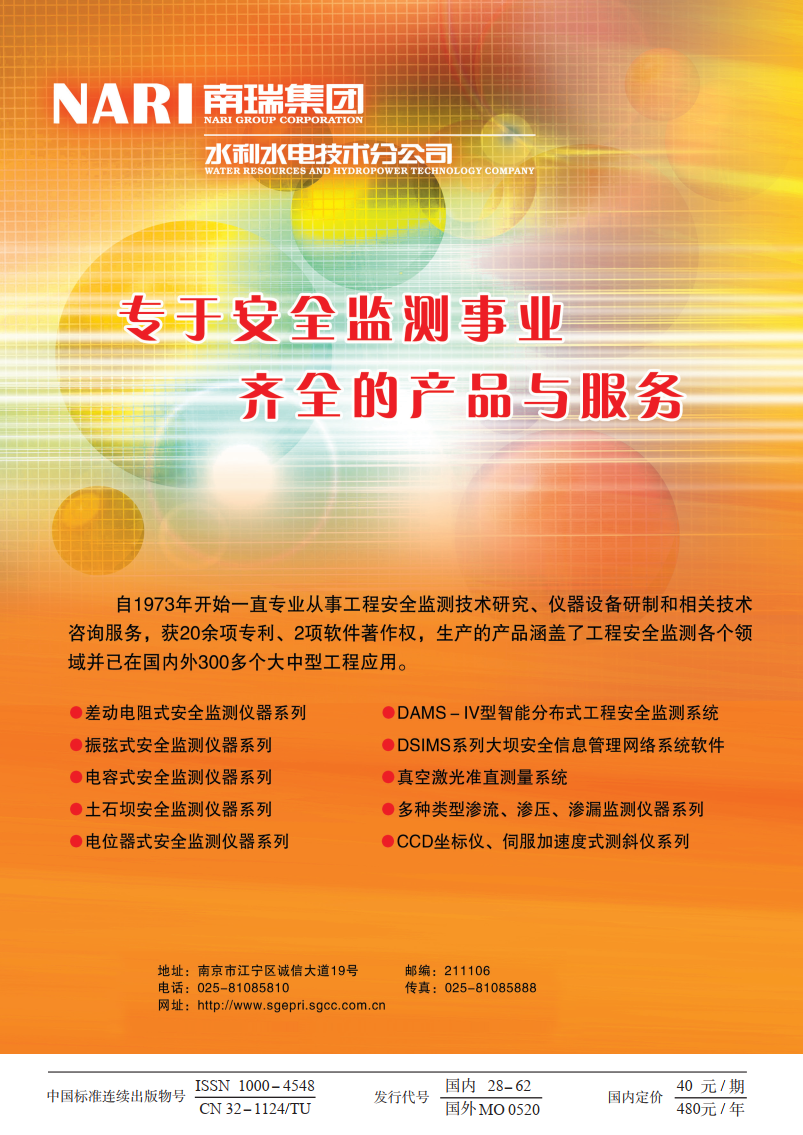Dynamic stability evaluation of submarine slopes with hydrate reservoir under influences of heat injection exploitation
-
摘要: 注热开采会破坏水合物储层的温压平衡,引发水合物分解、储层孔隙压力激增,进而可能诱发海底斜坡沿水合物层发生失稳滑动甚至大规模海底滑坡,因此研究开采影响下水合物储层的动态响应和海底斜坡实时稳定性十分重要。首先推导了一种考虑热-水-化(THC)耦合作用的实时超孔压求解格式,建立水合物饱和度与超孔压之间的内在关系;进一步,基于无限坡极限平衡理论,发展水合物注热开采下海底斜坡动态稳定性的简化评价方法,并开发相应的数值模拟及计算程序。利用该方法对中国南海北部陆坡第二次水合物试采区开展了深入分析,探究了注热开采过程中海底斜坡的温度剖面、水合物饱和度剖面和动态稳定性安全系数等演变特征,并提出了合理化的开采建议。研究成果为深刻认识水合物分解引起的海底斜坡失稳破坏机理、实现水合物的安全可持续开发和海洋地质灾害风险的科学评估提供了重要依据。Abstract: The heat injection exploitation will destroy the temperature and pressure balance of hydrate reservoirs, cause hydrate dissociation, lead to the dramatic increase of pore pressure of strata, and then induce the instability of submarine slopes along the hydrate reservoirs or even a large-scale submarine landslide. Therefore, it is very important to investigate the dynamic response of the hydrate reservoirs and the real-time stability of the submarine slopes after environmental changes. First, a solving equation for calculating the real-time excess pore pressure considering thermo-hydro-chemical (THC) coupling is derived, and the internal relation between the hydrate saturation and the excess pore pressure is also established. Further, a simplified evaluation approach for the dynamic stability of the submarine slopes under the influences of heat injection exploitation of the hydrate reservoirs is proposed based on the theory of infinite slope limit equilibrium analysis, and the corresponding numerical simulation and calculation code are developed. This approach is employed to analyze the submarine slope in the second hydrate extraction area on the northern continental slope of the South China Sea. The evolution characteristics of the submarine slopes in the process of heat injection exploitation of the hydrate reservoirs, such as the temperature profile, hydrate saturation profile and dynamic stability factors, are explored, and the reasonable mining suggestions are put forward. The research results provide an important basis for understanding the mechanism of instability of submarine slopes caused by hydrate dissociation, realizing the safe and sustainable development of the hydrate reservoirs and the scientific assessment of marine geological disaster risks.
-
0. 引言
土的结构性是决定各类土力学特性的一个最为根本的内在因素[1]。因此,要了解土体的工程性状,必须对土体的微细观结构进行研究。目前,研究土体结构性常采用的手段有压汞(MIP)试验、扫描电镜(SEM)试验、核磁共振(NMR)试验和计算机断层扫描(CT)试验。其中,MIP和NMR试验可以直接或间接获得土体的微观孔隙分布特征,但NMR试验只能获得饱和土体的孔隙结构信息,SEM试验可以获得土体的微观结构形态。根据仪器精度的大小,CT试验获得的土体结构信息一般认为是细观尺度的。Griffiths等[2]、Jiang等[3]和Wang等[4]研究了不同状态下土体的微观结构特征。为了更加全面地反映土体的孔隙结构特征,学者们还常常将两种试验结合来表征土体的孔隙结构特征[5-6]。与其他土体不同,裂隙性是是影响膨胀土渗透、强度和变形特性的重要影响因素,对揭示膨胀土灾变机制具有重要意义[7-9]。已有学者开展了对膨胀土裂隙发育规律的研究[10]。裂隙性膨胀土的结构包括微观尺度的孔隙结构与细观的裂隙结构,意味着单一的测试手段难以全面反映膨胀土的结构特征,对于评价膨胀土的工程特性存在局限性。为此,刘宽等[11]采用NMR和SEM试验,并结合数码相机拍照,从多尺度方面分析了干湿环境下膨胀土力学性能劣化机制,为膨胀土微细观结构的研究提供了新思路。
膨胀土富含亲水性黏土矿物,土体从高含水率脱湿至低含水率的过程中,常常会产生很多裂隙,因此,定量表征膨胀土的微细观结构特征及其随含水率的变化规律,对认识其工程特性行为至关重要。本文以膨胀土为研究对象,对不同含水率膨胀土进行了MIP试验,探究含水率对膨胀土孔隙分布的影响;借助SEM图像,更直观地解释含水率对膨胀土微观结构的影响。同时,采用CT扫描技术,对脱湿过程中裂隙的演化规律进行了研究。
1. 试验土样与方法
1.1 试验土样
土样为取自新疆的原状样,呈灰白色,裂隙发育。土的液限和塑限分别为72.5%和32.6%,自由膨胀率为97.3%,土体所含蒙脱土含量为46%,为强膨胀土。
1.2 试验方案
(1)微观孔隙结构试验
将原状样从饱和的状态脱湿至不同含水率进行MIP试验。首先,对环刀样进行饱和,再将其从环刀中推出,用钢丝锯小心将土样切割为1 cm3的方块,然后在温度为20℃的恒温室内脱湿,通过称重法得到不同含水率试样,冷冻干燥后开展MIP试验。本研究中所有试样含水率控制均为26.5%(饱和状态),20%,15%和10%。
(2)微观结构形态分析试验
SEM试验试样制备过程与MIP试验相似,当土体达到设计含水率并冷冻干燥后,用手小心掰出新鲜的断面进行观察。
(3)细观裂隙结构试验
采用CT扫描试验对土样的裂隙结构进行研究,仪器的最小分辨率51 um,大于一般的土体孔隙尺寸。因此,本研究中,将CT试验获得孔隙和裂隙,统称为裂隙。试验土样为Φ50×100 mm的圆柱体。将饱和试样放在温度为20℃的恒温室内进行脱湿,当试样脱湿至设定含水率后使用保鲜膜将其包裹,使水分均匀分布。最后,依次对不同含水率下的试样进行CT试验。
2. 膨胀土微细观结构演化特征
2.1 脱湿过程中膨胀土孔隙结构演化特征
原状膨胀土MIP试验结果如图 1所示。一定的压力下,退汞曲线对应的体积值比进汞曲线对应的体积值要大,说明退汞存在滞留现象。含水率越小,累积孔隙体积越小。含水率为10%的膨胀土最终累积孔隙体积比饱和样减少了53.2%。MIP试验测得的不同含水率试样的孔隙率随含水率的变化曲线如图 2所示,随着含水率的降低,孔隙率先线性快速减小后逐渐变缓,表明当土体含水率减小到一定程度时,含水率的减小所引起的孔隙体积的改变逐渐减小。
不同含水率试样的孔隙密度分布曲线如图 3所示,可以看出,新疆膨胀土具有明显的双峰孔隙特征。随着含水率的降低,团聚体间孔隙优势孔径和团聚体内孔隙的优势孔径减小。总体而言,在较高含水率下,团聚体间孔隙占主导地位,随着孔隙水的散失,团聚体间孔隙逐渐减小甚至消失,一部分较大孔隙转化为较小孔隙,孔隙组成以团聚体内孔隙为主。
2.2 脱湿过程中膨胀土微观结构形态分析
脱湿至不同含水率膨胀土的SEM图像见图 4~6。由于SEM试验和CT试验观察到的裂隙尺度不同,将SEM试验观察到的裂隙称为“微裂隙”。随着含水率的降低,“微裂隙”减少且宽度变窄,甚至逐渐闭合。当含水率为26.5%时,土体表面附着有大量的土碎片结构,这些碎片以架空的形式构成了架空孔隙(图 5(f)),这是饱和样具有疏松结构的主要原因。随着含水率的降低,土体表面少见碎片,说明土体的结构性较强。更大倍数下的SEM图像(图 6)显示,含水率较低时,片状颗粒呈卷曲状。当含水率较高时,以片状颗粒单元构成的团聚体间形成了较多的孔隙(图 5(e)),以及片状颗粒以点—面和边—面接触的形式形成了架空孔隙,随着含水率的降低,片状颗粒多以面—面接触的形式层层叠加,进而形成了较大的集聚体,土体中的孔隙以团聚体内的孔隙为主,这与压汞试验结果一致。
2.3 脱湿过程中膨胀土细观裂隙演化特征
随着脱湿的进行,膨胀土的表面形态变化如图 7所示。饱和状态下,试样表面存在一些微小的原始裂隙,这些裂隙多为闭合或微开状态。随着水分的散失,一些裂隙从已有的裂隙处开始向四周扩散。在脱湿的初期,肉眼可见的裂隙较少,分布较为分散,裂隙的扩展方向较为单一,如图 7(b)所示。随着水分的进一步散失,土体中裂隙快速发育,但裂隙的扩展方向没有明显的规律性,并产生了一些新的裂隙,裂隙之间的连通性也逐渐增加。当含水率为10%时,土样表面的裂隙宽度变宽,裂隙之间逐渐贯穿为联通的裂隙,如图 7(d)所示,土样表面的裂隙基本可以看作由两条贯通的裂隙组成。
本研究中将土样中原本存在的裂隙称为原始裂隙,由于脱湿产生的裂隙称为脱湿裂隙。脱湿过程中试样的二维切片如图 8所示,当含水率为26.5%时,试样中存在一定原始裂隙,裂隙形态主要为线状,较为集中的分布在一个区域。当含水率降低为20%时,从试样的边缘萌生出一些短而小的脱湿裂隙,内部裂隙没有发生明显变化。此时,试样中的裂隙以原始裂隙为主,随着含水率减小为15%时,边缘的脱湿裂隙向试样内部扩展,其内部的原始裂隙也逐渐发展并与其他裂隙贯通,同时,在试样的边缘依然不断产生新的脱湿裂隙,脱湿裂隙的增加速率明显增加。当含水率为10%时,裂隙分布于试样的各个区域。试样内部裂隙以原始裂隙为主干,并逐渐延长变宽,裂隙的主方向没有明显改变,而脱湿裂隙则表现为数量多、长度短、没有明显的方向性的特征。
对膨胀土裂隙重建其三维模型,如图 9所示。随着含水率的降低,裂隙的分布位置由集中在局部逐渐发展为分布于整个试样。使用Avizo软件对联通裂隙进行分析,结果如图 10所示。可以看出,当w=26.5%,联通的裂隙主要被分为上下两个主要的裂隙,上面的联通裂隙较大,下面的联通裂隙较小。当w=20%时,1、2部位的裂隙增密增长,3部位的裂隙也明显向上扩展。当w=15%时,1、2和3部位的裂隙有了更明显的发展。当含水率减小至10%时,联通裂隙几乎分布于整个土体中。总的来说,随着含水率的降低,裂隙更容易在已有裂隙的基础上向外发展。
得到的联通裂隙率、裂隙率变化,如图 11所示。与w>15%相比,当w<15%时,裂隙率随含水率的减小增加幅度明显更大。同时,联通裂隙率随着含水率的减小明显增加,这些数据与2.2节中观察到的二维图片和三维模型中裂隙的发展规律一致。进一步分析可知,裂隙率与联通裂隙率之间存在良好的正相关关系,如图 11(b)所示,表明膨胀土中的裂隙越多,裂隙之间的联通性增强,对土体结构的整体性损伤越来越大。
3. 膨胀土微细观结构演化机制与概化模型
从宏观角度来看,膨胀土由裂隙和土颗粒的团聚体组成,土颗粒的团聚体之间形成团聚体间孔隙和团聚体内孔隙,如图 12所示。事实上,裂隙也是团聚体间孔隙,但为了更清楚地表达裂隙与孔隙之间的区别,这里以裂隙、团聚体内孔隙和团聚体间孔隙来描述土中的孔隙。
团聚体的收缩累积到一定程度,表现为团聚体组内的团聚体颗粒之间的距离被拉的“更近”,从而团聚体间孔隙变小,团聚体组的收缩,宏观上表现为土体体积的收缩。事实上,自然界中土体的收缩是不均匀的,当团聚体组之间的张拉应力大于团聚体组之间的抗拉强度时,原本存在的裂隙会被“拉长”和“拉宽”,使得裂隙扩展发育为更大的裂隙,或者在“薄弱”的地方产生新的裂隙。相反,当张拉应力小于团聚体组之间的抗拉强度时,这些团聚体组则会凝聚成更为密实的结构,因此,膨胀土的结构表现为微观上团聚体间孔隙的减少和细观上裂隙增多的现象。值得注意的是,在SEM试验中,随着含水率的降低,观察到的“微裂隙”数量减少且宽度变窄,而在CT试验中,裂隙是逐渐增多的趋势,这是因为SEM观察到的裂隙是微观尺度的“微裂隙”(约30 um),这部分裂隙附近土体之间还存在较强的粘聚力,在脱湿的过程中,有可能在吸力的作用下被“拉近”,产生闭合的现象。而CT试验观察到的裂隙为细观尺度的裂隙,裂隙附近的土体之间粘聚力较弱,在脱湿的过程中,往往容易成为薄弱部位,从而发展为更大的裂隙。
事实上,孔隙体积的减小和裂隙体积的增加是同步产生的。当含水率从26.5%脱湿至15%时,微观上孔隙率的减小速率为单位含水率减小1.14%,而细观上裂隙率的减小速率为单位含水率减小0.125%;当含水率小于15%时,孔隙率的减小速率为单位含水率减小0.158%,裂隙率的增加速率为单位含水率减小0.35%。可以看出,孔隙体积的减小主要发生在脱湿的前期,裂隙的发育在脱湿后期更为明显。
4. 结论
(1)随着含水率的减小,膨胀土的孔隙率先快速减小后逐渐变缓。孔隙分布以团聚体间孔隙为主逐渐转变为以团聚体内孔隙占优势。
(2)膨胀土的颗粒单元以片状颗粒为主,当含水率较高时,土体中含有纵横交错的“微裂隙”和大量的架空孔隙,土体结构松散;随着含水率的降低,“微裂隙”数量减小且宽度变窄,土体结构渐趋紧密,SEM结果与MIP试验结果具有较好的一致性。
(3)随着水分的蒸发,原始裂隙在发育扩展过程中主方向基本不变,脱湿裂隙自试样外侧向内发展,数量多且杂乱无章。土体裂隙率随着含水率的降低而增加,当含水率小于15%时,裂隙率增加明显。联通裂隙率的增速随含水率的减小逐渐增加且与裂隙率之间具有正相关关系。
-
图 1 水合物实物与分子结构图[2]
Figure 1. Physical and molecular structural diagrams of hydrate
图 3 水合物理论稳定区域与生成区域的空间关系示意图[26]
Figure 3. Schematic diagram of spatial relationship between hydrate stability zone and hydrate formation zone
图 6 水合物开采影响下典型海底斜坡稳定性评价示意图[32]
Figure 6. Schematic diagram of stability evaluation of typical submarine slope under influences of hydrate exploitation
图 8 先导井测井响应柱状图[41]
Figure 8. Histogram logging response of pilot well
参数 取值 单位 坡体参数 z (深度) — m α (坡度) 3 ° H(水平井位置) 230.6 m 地层参数 T0(海底温度) 3.5 ℃ G/(地热梯度) 56 K/km Sh (初始饱和度) 31 % k (渗透率) 2.38 mD κ (有效热扩散系数) 4.5×10−7 m2/s λ (有效导热系数) 3.66 W/(m·K) c1′ (初始黏聚力) 800 kPa c2′ (最终黏聚力) 30 kPa φ′ (内摩擦角) 8.03 ° ρ (体密度) 1650 kg/m3 ϕ (孔隙度) 0.37 m3/m3 通用参数 ρl/(液相密度) 1024 kg/m3 ρh (水合物密度) 930 kg/m3 Cpl (液体比热) 4.18×103 J/(kg·K) Cph/(水合物比热) 2.16×103 J/(kg·K) μl (液体动态黏度) 8.87×10−4 kg/(m·s) S (液体盐度) 3.5 % Lh/(水合物潜热) 56552-16.8/T J/kg -
[1] KVENVOLDEN K A. Gas hydrates-geological perspective and global change[J]. Reviews of Geophysics, 1993, 31(2): 173–187. doi: 10.1029/93RG00268
[2] SLOAN E D Jr. Fundamental principles and applications of natural gas hydrates[J]. Nature, 2003, 426(6964): 353–363. doi: 10.1038/nature02135
[3] BOSWELL R, COLLETT T S, FRYE M, et al. Subsurface gas hydrates in the northern Gulf of Mexico[J]. Marine and Petroleum Geology, 2012, 34(1): 4–30. doi: 10.1016/j.marpetgeo.2011.10.003
[4] FUJII T, SUZUKI K, TAKAYAMA T, et al. Geological setting and characterization of a methane hydrate reservoir distributed at the first offshore production test site on the Daini-Atsumi Knoll in the eastern Nankai Trough, Japan[J]. Marine and Petroleum Geology, 2015, 66: 310–322. doi: 10.1016/j.marpetgeo.2015.02.037
[5] 萧惠中, 张振. 全球主要国家天然气水合物研究进展[J]. 海洋开发与管理, 2021, 38(1): 36–41. doi: 10.3969/j.issn.1005-9857.2021.01.006 XIAO Hui-zhong, ZHANG Zhen. A review on gas hydrates research progress of global main countries[J]. Ocean Development and Management, 2021, 38(1): 36–41. (in Chinese) doi: 10.3969/j.issn.1005-9857.2021.01.006
[6] 王力峰, 付少英, 梁金强, 等. 全球主要国家水合物探采计划与研究进展[J]. 中国地质, 2017, 44(3): 439-448. https://www.cnki.com.cn/Article/CJFDTOTAL-DIZI201703004.htm WANG Li-feng, FU Shao-ying, LIANG Jin-qiang, et al. A review on gas hydrate developments propped by worldwide national projects[J]. Geology in China, 2017, 44(3): 439-448. (in Chinese) https://www.cnki.com.cn/Article/CJFDTOTAL-DIZI201703004.htm
[7] 袁益龙. 海洋天然气水合物降压开采潜力及力学稳定性数值模拟研究[D]. 长春: 吉林大学, 2019. YUAN Yi-long. Numerical Simulation on Gas Production Potential and the Geo-Mechanical Stability From Marine Natural Gas Hydrate Through Depressurization[D]. Changchun: Jilin University, 2019. (in Chinese)
[8] 宁伏龙, 梁金强, 吴能友, 等. 中国天然气水合物赋存特征[J]. 天然气工业, 2020, 40(8): 1–24, 203. doi: 10.3787/j.issn.1000-0976.2020.08.001 NING Fu-long, LIANG Jin-qiang, WU Neng-you, et al. Reservoir characteristics of natural gas hydrates in China[J]. Natural Gas Industry, 2020, 40(8): 1–24, 203. (in Chinese) doi: 10.3787/j.issn.1000-0976.2020.08.001
[9] 张伟, 梁金强, 陆敬安, 等. 中国南海北部神狐海域高饱和度天然气水合物成藏特征及机制[J]. 石油勘探与开发, 2017, 44(5): 670–680. https://www.cnki.com.cn/Article/CJFDTOTAL-SKYK201705003.htm ZHANG Wei, LIANG Jin-qiang, LU Jin-gan, et al. Accumulation features and mechanisms of high saturation natural gas hydrate in Shenhu Area, northern South China Sea[J]. Petroleum Exploration and Development, 2017, 44(5): 670–680. (in Chinese) https://www.cnki.com.cn/Article/CJFDTOTAL-SKYK201705003.htm
[10] WANG J L, WU S G, KONG X, et al. Geophysical characterization of a fine-grained gas hydrate reservoir in the Shenhu area, northern South China Sea: integration of seismic data and downhole logs[J]. Marine and Petroleum Geology, 2018, 92: 895–903. doi: 10.1016/j.marpetgeo.2018.03.020
[11] 叶建良, 秦绪文, 谢文卫, 等. 中国南海天然气水合物第二次试采主要进展[J]. 中国地质, 2020, 47(3): 557–568. https://www.cnki.com.cn/Article/CJFDTOTAL-DIZI202003002.htm YE Jian-liang, QIN Xu-wen, XIE Wen-wei, et al. Main progress of the second gas hydrate trial production in the South China Sea[J]. Geology in China, 2020, 47(3): 557–568. (in Chinese) https://www.cnki.com.cn/Article/CJFDTOTAL-DIZI202003002.htm
[12] LI A, DAVIES R J, YANG J X. Gas trapped below hydrate as a primer for submarine slope failures[J]. Marine Geology, 2016, 380: 264–271. doi: 10.1016/j.margeo.2016.04.010
[13] NIAN T K, SONG X L, ZHAO W, et al. Submarine slope failure due to overpressure fluid associated with gas hydrate dissociation[J]. Environmental Geotechnics, 2022, 9(2): 108–123. doi: 10.1680/jenge.19.00070
[14] JIANG M J, SUN C, CROSTA G B, et al. A study of submarine steep slope failures triggered by thermal dissociation of methane hydrates using a coupled CFD-DEM approach[J]. Engineering Geology, 2015, 190: 1–16. doi: 10.1016/j.enggeo.2015.02.007
[15] NIXON M F, LH G J. Submarine slope failure due to gas hydrate dissociation: a preliminary quantification[J]. Canadian Geotechnical Journal, 2007, 44(3): 314–325. doi: 10.1139/t06-121
[16] XIONG Z S, ZHANG J H. Effect of dissociation of gas hydrate on the stability of submarine slope[C]//31st ASME International Conference on Ocean, Offshore and Arctic Engineering. Rio de Janeiro, 2012.
[17] ZHANG H T, LUO X Q, BI J F, et al. Submarine slope stability analysis during natural gas hydrate dissociation[J]. Marine Georesources & Geotechnology, 2019, 37(4): 467–476.
[18] CHEN Y M, ZHANG L L, LIAO C C, et al. A two-stage probabilistic approach for the risk assessment of submarine landslides induced by gas hydrate exploitation[J]. Applied Ocean Research, 2020, 99: 102158. doi: 10.1016/j.apor.2020.102158
[19] 刘锋, 吴时国, 孙运宝. 南海北部陆坡水合物分解引起海底不稳定性的定量分析[J]. 地球物理学报, 2010, 53(4): 946–953. doi: 10.3969/j.issn.0001-5733.2010.04.019 LIU Feng, WU Shi-guo, SUN Yun-bao. A quantitative analysis for submarine slope instability of the northern South China Sea due to gas hydrate dissociation[J]. Chinese Journal of Geophysics, 2010, 53(4): 946–953. (in Chinese) doi: 10.3969/j.issn.0001-5733.2010.04.019
[20] GROZIC J L H. Interplay Between gas hydrates and submarine slope failure[C]// Submarine Mass Movements and Their Consequences-4th International Symposium, Dordrecht, 2010.
[21] ZHU C Q, JIA Y G. Submarine slope stability analysis during natural gas hydrate dissociation: Discussion[J]. Marine Georesources & Geotechnology, 2020, 38(6): 753–754.
[22] ARCHER D, BUFFETT B, BROVKIN V. Ocean methane hydrates as a slow tipping point in the global carbon cycle[J]. Proceedings of the National Academy of Sciences of the United States of America, 2009, 106(49): 20596–20601. doi: 10.1073/pnas.0800885105
[23] XU W Y, RUPPEL C. Predicting the occurrence, distribution, and evolution of methane gas hydrate in porous marine sediments[J]. Journal of Geophysical Research: Solid Earth, 1999, 104(B3): 5081–5095. doi: 10.1029/1998JB900092
[24] SLOAN E D, KOH C A. Clathrate Hydrates of Natural Gases[M]. 3ir ed. New York: Marcel Dekker, 2008.
[25] DAVIE M K, ZATSEPINA O Y, BUFFETT B A. Methane solubility in marine hydrate environments[J]. Marine Geology, 2004, 203(1/2): 177–184.
[26] MESTDAGH T, POORT J, DE B M. The sensitivity of gas hydrate reservoirs to climate change: perspectives from a new combined model for permafrost-related and marine settings[J]. Earth-Science Reviews, 2017, 169: 104–131. http://hal.sorbonne-universite.fr/hal-01521071/document
[27] WAITE W F, STERN L A, KIRBY S H, et al. Simultaneous determination of thermal conductivity, thermal diffusivity and specific heat in SI methane hydrate[J]. Geophysical Journal International, 2007, 169(2): 767–774. doi: 10.1111/j.1365-246X.2007.03382.x
[28] HU H, ARGYROPOULOS S A. Mathematical modelling of solidification and melting: a review[J]. Modelling and Simulation in Materials Science and Engineering, 1996, 4(4): 371–396. doi: 10.1088/0965-0393/4/4/004
[29] REAGAN M T, MORIDIS G J. Dynamic response of oceanic hydrate deposits to ocean temperature change[J]. Journal of Geophysical Research Oceans, 2008, 113(C12).
[30] TAN L, LIU F, HUANG Y, et al. Production-induced instability of a gentle submarine slope: potential impact of gas hydrate exploitation with the huff-puff method[J]. Engineering Geology, 2021, 289: 106174.
[31] 蒋明镜, 陈意茹, 卢国文. 一种实用型深海能源土多场耦合离散元数值方法[J]. 岩土工程学报, 2021, 43(8): 1391–1398. http://manu31.magtech.com.cn/Jwk_ytgcxb/CN/abstract/abstract18686.shtml JIANG Ming-jing, CHEN Yi-ru, LU Guo-wen. A practical multi-field coupling distinct element method for methane hydrate bearing sediments[J]. Chinese Journal of Geotechnical Engineering, 2021, 43(8): 1391–1398. (in Chinese) http://manu31.magtech.com.cn/Jwk_ytgcxb/CN/abstract/abstract18686.shtml
[32] LIU F, TAN L, CROSTA G, et al. Spatiotemporal destabilization modes of upper continental slopes undergoing hydrate dissociation[J]. Engineering Geology, 2020, 264: 105286.
[33] 邹远晶, 韦昌富, 陈合龙, 等. 基于扰动状态概念的含水合物土弹塑性模型[J]. 岩土力学, 2019, 40(7): 2653–2662. https://www.cnki.com.cn/Article/CJFDTOTAL-YTLX201907019.htm ZOU Yuan-jing, WEI Chang-fu, CHEN He-long, et al. Elastic-plastic model for gas-hydrate-bearing soils using disturbed state concept[J]. Rock and Soil Mechanics, 2019, 40(7): 2653–2662. (in Chinese) https://www.cnki.com.cn/Article/CJFDTOTAL-YTLX201907019.htm
[34] 杨胜雄, 梁金强, 陆敬安, 等. 南海北部神狐海域天然气水合物成藏特征及主控因素新认识[J]. 地学前缘, 2017, 24(4): 1–14. https://www.cnki.com.cn/Article/CJFDTOTAL-DXQY201704002.htm YANG Sheng-xiong, LIANG Jin-qiang, LU Jin-gan, et al. New understandings on the characteristics and controlling factors of gas hydrate reservoirs in the Shenhu area on the northern slope of the South China Sea[J]. Earth Science Frontiers, 2017, 24(4): 1–14. (in Chinese) https://www.cnki.com.cn/Article/CJFDTOTAL-DXQY201704002.htm
[35] 年廷凯, 焦厚滨, 范宁, 等. 南海北部陆坡软黏土动力应变-孔压特性试验[J]. 岩土力学, 2018, 39(5): 1564–1572, 1580. NIAN Ting-kai, JIAO Hou-bin, FAN Ning, et al. Experiment on dynamic strain-pore pressure of soft clay in the northern slope of South China Sea[J]. Rock and Soil Mechanics, 2018, 39(5): 1564–1572, 1580. (in Chinese)
[36] 年廷凯, 范宁, 焦厚滨, 等. 南海北部陆坡软黏土全流动强度试验研究[J]. 岩土工程学报, 2018, 40(4): 602–611. http://manu31.magtech.com.cn/Jwk_ytgcxb/CN/abstract/abstract17326.shtml NIAN Ting-kai, FAN Ning, JIAO Hou-bin, et al. Full-flow strength tests on the soft clay in the northern slope of the South China Sea[J]. Chinese Journal of Geotechnical Engineering, 2018, 40(4): 602–611. (in Chinese) http://manu31.magtech.com.cn/Jwk_ytgcxb/CN/abstract/abstract17326.shtml
[37] 蒋明镜, 肖俞, 刘芳. 深海能源土开采对海床稳定性的影响研究思路[J]. 岩土工程学报, 2010, 32(9): 1412–1417. http://manu31.magtech.com.cn/Jwk_ytgcxb/CN/abstract/abstract13601.shtml JIANG Ming-jing, XIAO Yu, LIU Fang. Methodology for assessing seabed instability induced by exploitation of methane hydrate[J]. Chinese Journal of Geotechnical Engineering, 2010, 32(9): 1412–1417. (in Chinese) http://manu31.magtech.com.cn/Jwk_ytgcxb/CN/abstract/abstract13601.shtml
[38] 年廷凯, 沈月强, 郑德凤, 等. 海底滑坡链式灾害研究进展[J]. 工程地质学报, 2021, 29(6): 1657–1675. https://www.cnki.com.cn/Article/CJFDTOTAL-GCDZ202106001.htm NIAN Ting-kai, SHEN Yue-qiang, ZHENG De-feng, et al. Research advances on the chain disasters of submarine landslides[J]. Journal of Engineering Geology, 2021, 29(6): 1657–1675. (in Chinese) https://www.cnki.com.cn/Article/CJFDTOTAL-GCDZ202106001.htm
[39] 郑德凤, 雷得浴, 闫成林, 等. 基于Web of Science数据库的海底滑坡研究趋势文献计量分析[J]. 工程地质学报, 2021, 29(6): 1805–1814. https://www.cnki.com.cn/Article/CJFDTOTAL-GCDZ202106015.htm ZHENG De-feng, LEI De-yu, YAN Cheng-lin, et al. Global research trends in submarine landslides: a bibliometric analysis based on web of science publications[J]. Journal of Engineering Geology, 2021, 29(6): 1805–1814. (in Chinese) https://www.cnki.com.cn/Article/CJFDTOTAL-GCDZ202106015.htm
[40] 吴时国, 董冬冬, 杨胜雄, 等. 南海北部陆坡细粒沉积物天然气水合物系统的形成模式初探[J]. 地球物理学报, 2009, 52(7): 1849–1857. https://www.cnki.com.cn/Article/CJFDTOTAL-DQWX200907020.htm WU Shi-guo, DONG Dong-dong, YANG Sheng-xiong, et al. Genetic model of the hydrate system in the fine grain sediments in the northern continental slope of South China Sea[J]. Chinese Journal of Geophysics, 2009, 52(7): 1849–1857. (in Chinese) https://www.cnki.com.cn/Article/CJFDTOTAL-DQWX200907020.htm
[41] QIN X W, LU J A, LU H, et al. Co-existence of gas hydrate, free gas, and water in gas hydrate reservoir system in Shenhu area[J]. China Geology, 2020, 3(2): 210–220.
[42] 石要红, 张旭辉, 鲁晓兵, 等. 南海水合物黏土沉积物力学特性试验模拟研究[J]. 力学学报, 2015, 47(3): 521–528. https://www.cnki.com.cn/Article/CJFDTOTAL-LXXB201503016.htm SHI Yao-hong, ZHANG Xu-hui, LU Xiao-bing, et al. Experimental study on the static mechanical properties of hydrate-bearing silty-clay in the South China Sea[J]. Chinese Journal of Theoretical and Applied Mechanics, 2015, 47(3): 521–528. (in Chinese) https://www.cnki.com.cn/Article/CJFDTOTAL-LXXB201503016.htm
-
期刊类型引用(12)
1. 何长江. 基于最小势能原理的深基坑吊脚墙变形研究. 江西建材. 2024(02): 71-73 .  百度学术
百度学术
2. 金国龙,张永来,李鸿桥. 地下连续墙新型刚性接头设计与研究. 建筑施工. 2024(05): 629-631 .  百度学术
百度学术
3. 罗会东,周佳奇,冯志军,叶涛,薛高升,周腾龙,曹安乐. 地下连续墙刚性排插接头技术研究. 施工技术(中英文). 2024(16): 33-38 .  百度学术
百度学术
4. 夏欢,曾旭涛,付金磊,朱俊涛,屈成. 超深异型排插式刚性接头地连墙工艺试验研究. 地下空间与工程学报. 2024(06): 2020-2033 .  百度学术
百度学术
5. 陈亮,颜书法,万昱. 跨孔电法探测地下连续墙渗漏隐患的应用研究. 岩土工程学报. 2023(08): 1605-1614 .  本站查看
本站查看
6. 姚云龙,刘鑫,古剑,王智健,倪嘉辉. 地下连续墙钢箱接头力学性能研究. 三峡大学学报(自然科学版). 2022(04): 57-63 .  百度学术
百度学术
7. 陈平,黄海涛,安刚建,周雄好,罗支贵,蔡虹,袁正璞. 软弱地层深大基坑富水特性及组合支护控制. 科学技术与工程. 2022(15): 6278-6290 .  百度学术
百度学术
8. 汪洵. 地下连续墙在含水地层基坑开挖中的应用研究. 地下水. 2022(06): 40-42 .  百度学术
百度学术
9. 田德胜. 分节预制地下连续墙围护结构加固施工技术. 粉煤灰综合利用. 2022(05): 22-28 .  百度学术
百度学术
10. 罗震刚,周晨,王晶,陈伟,马栋魁,沈才华. 地连墙兼作水池壁板的接头质量控制参数及厚度优化研究. 河南科学. 2020(05): 749-754 .  百度学术
百度学术
11. 刘颖,相斌辉,扶名福. 沿海地区复杂地质条件下三角形深大基坑变形实测分析与数值模拟研究. 水资源与水工程学报. 2020(05): 207-212+217 .  百度学术
百度学术
12. 杜昌隆,赵强,薛洪松. 洞内狭小空间中地下连续墙施工关键技术. 市政技术. 2020(06): 187-190+194 .  百度学术
百度学术
其他类型引用(16)
-
其他相关附件
-
PDF格式
审稿意见与作者答复 点击下载(518KB)
-




 下载:
下载:












